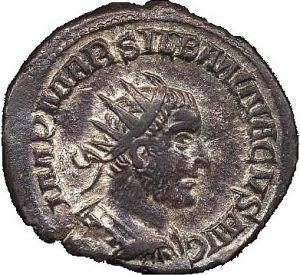| Silbannacus | |
|---|---|
 |
|
| Roman Emperor or usurper | |
| In Power | Sometimes between 248-253 |
Silbannacus is an obscure figure believed to have held power either around the time of Philip the Arab (244 – 249) or between Amelianus’ death and Valerianus’ reign (253). Proof of his existence is supported by only two coins.
The first coin was found in 1937 in Lorraine, France. Its obverse bears the portrait of a young man with a beardless chin and the inscription “IMP MAR SILBANNACVS AVG (Imperator Marcus Silbannacus Augustus), which means “Supreme Commander Marcus Silbannacus, emperor.” The reverse shows Mercury holding a cane with two snakes entwining it, with the inscription “VICTORIA AVG”, which means “Augusta Victory.” The pattern and the silver composition of the coin allowed experts to date it to the time of Philip the Arab’s reign, which was a time plagued by numerous civil wars. It is possible that Silbannacus was an army commander who revolted against Philip and declared himself emperor. This theory may be further supported by the historian, Eutropius, who wrote of a failed civil war in Gaul during Philip’s time.
In the 1980s, a second coin was found near Paris, with its obverse showing the same image and inscription as the first coin. However, its reverse shows the inscription “MARTI PROPOVGT”, meaning “To Mars, the Defender.” This inscription can also be seen on the coins used by Aemilianus, a commander who became emperor by defeating Trebonianus Gallus. Aemilianus, however, was killed by his own men, who were terrified of the arrival of a much stronger army led by Valerianus. It is, therefore, a more plausible theory that Silbannacus was one of Aemilianus’ officers who took control of Rome and the coin workshop before Valerianus ousted him.